World Roundup
May/June 2019
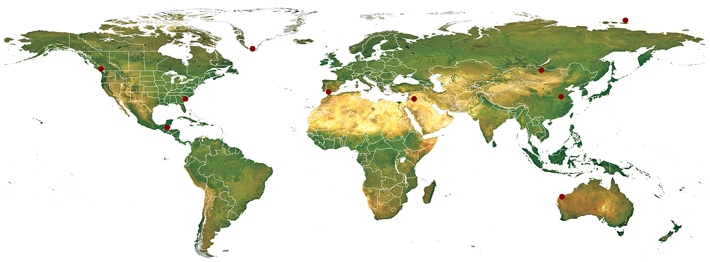

-
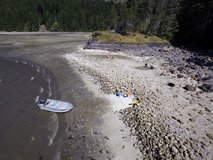 CANADA: Several unassuming rock walls along the shore of Quadra Island are actually the ruins of ancient clam gardens constructed by First Nations peoples thousands of years ago. The walls were erected within intertidal zones to create sandy terraces, ideal habitats for shellfish such as littleneck and butter clams. Radiocarbon dating of organic material sampled from one wall indicates it was built nearly 3,500 years ago, making it the oldest known aquaculture system of its kind.
CANADA: Several unassuming rock walls along the shore of Quadra Island are actually the ruins of ancient clam gardens constructed by First Nations peoples thousands of years ago. The walls were erected within intertidal zones to create sandy terraces, ideal habitats for shellfish such as littleneck and butter clams. Radiocarbon dating of organic material sampled from one wall indicates it was built nearly 3,500 years ago, making it the oldest known aquaculture system of its kind. -
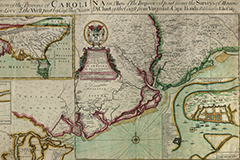 SOUTH CAROLINA: A piece of Charleston’s history was revealed when construction workers encountered a section of the city’s colonial defensive network. Charleston was one of the most heavily fortified English colonial cities in America. Its defenses offered protection against potential Spanish and French attacks. Construction began on a red brick wall along the city’s waterfront in the late 17th century, but the structure was dismantled after the Revolutionary War. Very few traces remain visible today.
SOUTH CAROLINA: A piece of Charleston’s history was revealed when construction workers encountered a section of the city’s colonial defensive network. Charleston was one of the most heavily fortified English colonial cities in America. Its defenses offered protection against potential Spanish and French attacks. Construction began on a red brick wall along the city’s waterfront in the late 17th century, but the structure was dismantled after the Revolutionary War. Very few traces remain visible today. -
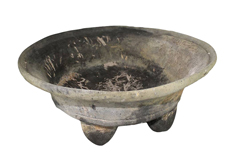 GUATEMALA: Divers have found hundreds of intact Maya artifacts lying 500 feet underwater in Lake Peten Itza. The objects, which include ceramic bowls, incense burners, obsidian knives, and musical instruments, were likely thrown into the lake during ritual ceremonies. Water was sacred to the Maya, as it was seen as a portal between the living and the dead. Many Maya rituals involved lakes and cenotes.
GUATEMALA: Divers have found hundreds of intact Maya artifacts lying 500 feet underwater in Lake Peten Itza. The objects, which include ceramic bowls, incense burners, obsidian knives, and musical instruments, were likely thrown into the lake during ritual ceremonies. Water was sacred to the Maya, as it was seen as a portal between the living and the dead. Many Maya rituals involved lakes and cenotes. -
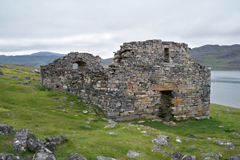 GREENLAND: Viking legend holds that Erik the Red devised the name “Greenland” in order to attract settlers to the notoriously cold island. A new study suggests the name wasn’t so misleading after all. By analyzing oxygen isotopes from flies trapped in ancient lake sediments, scientists concluded that summer temperatures on the island regularly reached 50°F during the age of Norse colonization (10th–15th centuries). When the climate cooled dramatically at the end of this period, the Norse settlements disappeared.
GREENLAND: Viking legend holds that Erik the Red devised the name “Greenland” in order to attract settlers to the notoriously cold island. A new study suggests the name wasn’t so misleading after all. By analyzing oxygen isotopes from flies trapped in ancient lake sediments, scientists concluded that summer temperatures on the island regularly reached 50°F during the age of Norse colonization (10th–15th centuries). When the climate cooled dramatically at the end of this period, the Norse settlements disappeared. -
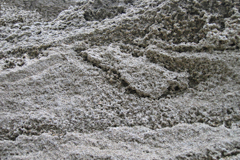 SPAIN: Animals including red deer, ibex, aurochs, leopards, and even elephants living near the Rock of Gibraltar left their tracks in the peninsula’s large coastal sand dunes some 29,000 years ago. Alongside the animal tracks, archaeologists have also identified the likely footprint of a Neanderthal, which would be only the second such impression ever recorded. Modern humans replaced Neanderthals throughout Europe around 40,000 years ago, but a small population is thought to have survived a bit longer at the continent’s southernmost point.
SPAIN: Animals including red deer, ibex, aurochs, leopards, and even elephants living near the Rock of Gibraltar left their tracks in the peninsula’s large coastal sand dunes some 29,000 years ago. Alongside the animal tracks, archaeologists have also identified the likely footprint of a Neanderthal, which would be only the second such impression ever recorded. Modern humans replaced Neanderthals throughout Europe around 40,000 years ago, but a small population is thought to have survived a bit longer at the continent’s southernmost point. -
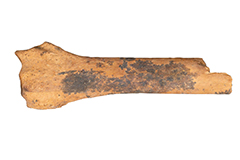 JORDAN: Humans and dogs have been best buddies for thousands of years, although for exactly how long is debated. Canine bones from a site called Shubayqa 6 indicate that the mutually beneficial relationship dates back at least 11,500 years. Researchers found a sharp increase in the number of small animal bones at the site dating to this same period. This suggests dogs may have helped humans catch smaller, more elusive prey such as hares, perhaps by driving them into nets or enclosures.
JORDAN: Humans and dogs have been best buddies for thousands of years, although for exactly how long is debated. Canine bones from a site called Shubayqa 6 indicate that the mutually beneficial relationship dates back at least 11,500 years. Researchers found a sharp increase in the number of small animal bones at the site dating to this same period. This suggests dogs may have helped humans catch smaller, more elusive prey such as hares, perhaps by driving them into nets or enclosures. -
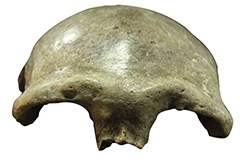 MONGOLIA: New dating of a skull originally dubbed Mongolanthropus has revealed it is 8,000 years older than once thought, and actually belonged to a modern human. When the 35,000-year-old hominin fossil was first uncovered in the Salkhit Valley, it was thought to belong to a previously unknown species. Recent DNA analysis has shown that the remains are undoubtedly Homo sapiens, making it the earliest known human bone fragment ever found in the region.
MONGOLIA: New dating of a skull originally dubbed Mongolanthropus has revealed it is 8,000 years older than once thought, and actually belonged to a modern human. When the 35,000-year-old hominin fossil was first uncovered in the Salkhit Valley, it was thought to belong to a previously unknown species. Recent DNA analysis has shown that the remains are undoubtedly Homo sapiens, making it the earliest known human bone fragment ever found in the region. -
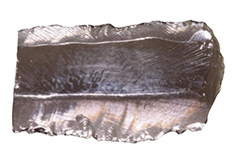 RUSSIA: Today, Zhokov Island lies more than 300 miles north of mainland Russia, far beyond the Arctic Circle. Around 9,000 years ago, though, when it was still attached to Siberia, the area was home to a surprisingly well-connected and mobile community. Obsidian tools discovered on the island came from a source more than 900 miles away. It is believed that Mesolithic Zhokovians traveled by dogsled to acquire the material, although it is unclear whether they trekked the entire way or met obsidian traders somewhere along the route.
RUSSIA: Today, Zhokov Island lies more than 300 miles north of mainland Russia, far beyond the Arctic Circle. Around 9,000 years ago, though, when it was still attached to Siberia, the area was home to a surprisingly well-connected and mobile community. Obsidian tools discovered on the island came from a source more than 900 miles away. It is believed that Mesolithic Zhokovians traveled by dogsled to acquire the material, although it is unclear whether they trekked the entire way or met obsidian traders somewhere along the route. -
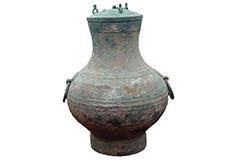 CHINA: A wealthy individual living 2,000 years ago in Henan Province was buried with an assortment of fine bronze, jade, and ceramic objects. Amid this trove was a jar containing a yellow liquid, which chemical analysis has revealed to be a mixture of potassium nitrate and alunite—and not rice wine as first thought. The minerals are the main ingredients of the legendary “elixir of immortality” mentioned in ancient Chinese texts. This potion was said to bring eternal life to whoever drank it, though, at least in this case, it doesn’t appear to have succeeded.
CHINA: A wealthy individual living 2,000 years ago in Henan Province was buried with an assortment of fine bronze, jade, and ceramic objects. Amid this trove was a jar containing a yellow liquid, which chemical analysis has revealed to be a mixture of potassium nitrate and alunite—and not rice wine as first thought. The minerals are the main ingredients of the legendary “elixir of immortality” mentioned in ancient Chinese texts. This potion was said to bring eternal life to whoever drank it, though, at least in this case, it doesn’t appear to have succeeded. -
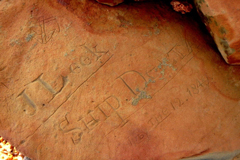 AUSTRALIA: On the Dampier Archipelago off the northwest coast of Australia, there are an estimated 1 million Aboriginal petroglyphs. There are also some made by American whalers in the mid-19th century. The recently discovered engravings were left by crewmen from the ships Connecticut and Delta, who documented their journeys to the other side of the world. The inscriptions include the ships’ names, names of crewmen, sailing dates, and even a crudely drawn rope and anchor. They represent the earliest known evidence of American whalers in the area.
AUSTRALIA: On the Dampier Archipelago off the northwest coast of Australia, there are an estimated 1 million Aboriginal petroglyphs. There are also some made by American whalers in the mid-19th century. The recently discovered engravings were left by crewmen from the ships Connecticut and Delta, who documented their journeys to the other side of the world. The inscriptions include the ships’ names, names of crewmen, sailing dates, and even a crudely drawn rope and anchor. They represent the earliest known evidence of American whalers in the area.
Advertisement
IN THIS ISSUE
Features
Mapping the Past
Bringing Back Moche Badminton
Inside King Tut’s Tomb
Letter from the Dead Sea
From the Trenches
Epic Proportions
Off the Grid
Stabbed in the Back
A Fox in the House
Tigress by the Tail
Family Secrets
Cold War Storage
Marrow of Humanity
Maya Beekeepers
Roman Soldier Scribbles
Understanding Hornet's Fate
Viking Warrioress
Colonial Cooling
Temple of the Flayed Lord
Celtic Curiosity
Submerged Scottish Forest
World Roundup
American whaler petroglyphs, Chinese “elixir of immortality,” Neanderthal footprints, and Ice Age rabbit hunting
Artifact
At some point in the past
Advertisement

Recent Issues
-
 May/June 2024
May/June 2024
-
 March/April 2024
March/April 2024
-
 January/February 2024
January/February 2024
-
 November/December 2023
November/December 2023
-
 September/October 2023
September/October 2023
-
 July/August 2023
July/August 2023
-
 May/June 2023
May/June 2023
-
 March/April 2023
March/April 2023
-
 January/February 2023
January/February 2023
-
 November/December 2022
November/December 2022
-
 September/October 2022
September/October 2022
-
 July/August 2022
July/August 2022
-
 May/June 2022
May/June 2022
-
 March/April 2022
March/April 2022
-
 January/February 2022
January/February 2022
-
 November/December 2021
November/December 2021
-
 September/October 2021
September/October 2021
-
 July/August 2021
July/August 2021
-
 May/June 2021
May/June 2021
-
 March/April 2021
March/April 2021
-
 January/February 2021
January/February 2021
-
 November/December 2020
November/December 2020
-
 September/October 2020
September/October 2020
-
 July/August 2020
July/August 2020
-
 May/June 2020
May/June 2020
-
 March/April 2020
March/April 2020
-
 January/February 2020
January/February 2020
-
 November/December 2019
November/December 2019
-
 September/October 2019
September/October 2019
-
 July/August 2019
July/August 2019
-
 May/June 2019
May/June 2019
-
 March/April 2019
March/April 2019
-
 January/February 2019
January/February 2019
-
 November/December 2018
November/December 2018
-
 September/October 2018
September/October 2018
-
 July/August 2018
July/August 2018
-
 May/June 2018
May/June 2018
-
 March/April 2018
March/April 2018
-
 January/February 2018
January/February 2018
-
 November/December 2017
November/December 2017
-
 September/October 2017
September/October 2017
-
 July/August 2017
July/August 2017
-
 May/June 2017
May/June 2017
-
 March/April 2017
March/April 2017
-
 January/February 2017
January/February 2017
-
 November/December 2016
November/December 2016
-
 September/October 2016
September/October 2016
-
 July/August 2016
July/August 2016
-
 May/June 2016
May/June 2016
-
 March/April 2016
March/April 2016
-
 January/February 2016
January/February 2016
-
 November/December 2015
November/December 2015
-
 September/October 2015
September/October 2015
-
 July/August 2015
July/August 2015
-
 May/June 2015
May/June 2015
-
 March/April 2015
March/April 2015
-
 January/February 2015
January/February 2015
-
 November/December 2014
November/December 2014
-
 September/October 2014
September/October 2014
-
 July/August 2014
July/August 2014
-
 May/June 2014
May/June 2014
-
 March/April 2014
March/April 2014
-
 January/February 2014
January/February 2014
-
 November/December 2013
November/December 2013
-
 September/October 2013
September/October 2013
-
 July/August 2013
July/August 2013
-
 May/June 2013
May/June 2013
-
 March/April 2013
March/April 2013
-
 January/February 2013
January/February 2013
-
 November/December 2012
November/December 2012
-
 Sep/Oct 2012
Sep/Oct 2012
-
 September/October 2012
September/October 2012
-
 July/August 2012
July/August 2012
-
 May/June 2012
May/June 2012
-
 March/April 2012
March/April 2012
-
 January/February 2012
January/February 2012
-
 November/December 2011
November/December 2011
-
 September/October 2011
September/October 2011
-
 July/August 2011
July/August 2011
-
 May/June 2011
May/June 2011
-
 March/April 2011
March/April 2011
-
 January/February 2011
January/February 2011
Advertisement






